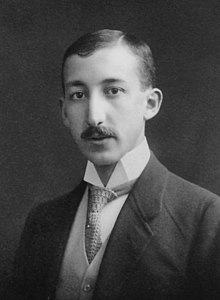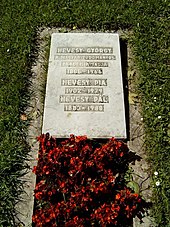George de Hevesy
George Charles de Hevesy (actually György Hevesy , also Georg Karl von Hevesy ; born August 1, 1885 in Budapest , Austria-Hungary , † July 5, 1966 in Freiburg im Breisgau , Germany ) was a Hungarian chemist and Nobel Prize winner .
Family background
The parents of Georg von Hevesys were the vice-president of the Upper Hungarian Mining and Steel Works Ludwig (Lajos) Bischitz de Heves (born October 16, 1853 in Pest ; † August 13, 1920 in Budapest) and Jenny (Eugenie) Baronesse Schosberger de Tornya (* approx . 1857; † April 10, 1931 in Budapest), daughter of the Budapest industrialist Sigmund von Schossberger and Therese Mayer from Vienna. The Hevesy family came from the Budapest Jewish upper middle class. Ludwig Bischitz de Heves had Magyarized the spelling of his name in Bisicz early on, but received permission to change the name to Hevesy-Bisicz de Heves on April 13, 1904, and then on December 25, 1906, he received permission to himself to be allowed to name only Hevesy de Heves or just de Hevesy . The paternal grandfather of George de Hevesys, David Bischitz, received the hereditary Hungarian nobility with the title de Heves in 1895 , his wife Johanna geb. Fischer was one of the most important Jewish philanthropists of the 19th century.
Live and act
Hevesy studied chemistry, mathematics and physics in Budapest, Berlin and Freiburg. In 1908 he was at Georg Franz Julius Meyer at the University of Freiburg with the work of these metals over the schmelzelektrolytische deposition of the alkali metals from caustic and the solubility in the melt doctorate . In 1911 he was with Ernest Rutherford in Manchester, where he met Niels Bohr , who became a lifelong friend. There he worked in particular on radioactive decay series and on the question of which elements and isotopes come from which original elements in these decay series, which required laborious chemical investigations. During this time he also took part in the discovery of Fajans-Soddyian displacement theorems (at the end of 1912 he made a stopover at Fajans in Karlsruhe on his journey home to Hungary). In 1912 he met Friedrich Adolf Paneth at the Radium Institute in Vienna, with whom he became friends, and then went on to Budapest. In 1913 he completed his habilitation in Budapest (reviewer was the physical chemist Gustav Buchböck ). In his habilitation, he presented Rutherford's new ideas for the construction of atomic nuclei. Although there was also a radium laboratory in Budapest, headed by Julius von Weszelsky , he had hardly any contact and mostly worked with Paneth in Vienna. At that time, one of Hevesy's research focuses was the chemical isolation of radium D (this is what the isotope lead 210 in the uranium-radium series was called at the time), which ultimately turned out to be impossible. Hevesy came to the conclusion that radium D could be used as a tracer for lead, the beginning of his tracer method, published with Paneth in 1913. Later in 1913 he went back to Manchester, where he dealt with the separation of chemical non-separable elements and isotopes by diffusion. He worked with Laszlo Putnoky on, among other things, the diffusion of uranium. He traveled a lot and changed between England and Central European research centers (Budapest, Vienna, Holland, Germany), while in England he also stayed with Henry Moseley in Oxford to learn X-ray crystallography, and in London. At that time he was still aiming for a career in Hungary, where he spent most of the time during the First World War and in the first post-war years and built a research laboratory in the 3rd Chemical Institute of the University of Budapest, which was headed by the physical chemist Gustav Buchböck, who was a friend of Hevesy. Although he served in the army in World War I, he was able to continue his research. He had hardly any contact with Weszelsky's existing radioactivity laboratory. In 1919 he became associate professor in Budapest and in 1919 full professor and head of the 2nd Physics Institute (which was intended as a transition before a chair for physical chemistry was established). His contact with the 3rd Chemical Institute in Buchböck waned, although he was still on good terms with Buchböck, and he experimented mainly in the veterinary school, whose chemical department was headed by his friend Gyula Groh. Erzsebet Rona was one of his students at that time and he worked with László Zechmeister . After the communist revolution in 1920 he lost his professorship and his teaching license and accepted an offer from Niels Bohr to go to Copenhagen. In Copenhagen in 1922 he discovered the element hafnium together with Dirk Coster .
He is one of the founders of radiochemistry and, together with Paneth, invented the tracer method , with which chemical elements are analytically identified by adding their radioactive isotopes . He also introduced neutron activation analysis as an analytical method.
From 1926 to 1934 he was a professor at the Albert Ludwig University of Freiburg . After the National Socialists came to power , he fled to Copenhagen and in 1943 to Stockholm . Until 1961, Hevesy worked in Stockholm and turned to physiological and clinical issues in the field of radiobiology.
After Carl von Ossietzky had received the Nobel Peace Prize as an opponent of National Socialism in 1935 , the Nazi government forbade Germans to accept or wear the Nobel Prize. That is why Max von Laue and James Franck, also in opposition to National Socialism, had entrusted their medals to Niels Bohr in Copenhagen in order to prevent their confiscation in Germany. When German troops occupied the Danish capital during the Second World War in April 1940, George de Hevesy dissolved the gold Nobel Prize medals of the two German physicists in aqua regia in order to prevent the occupiers from accessing them. After the end of the war, de Hevesy extracted the gold dissolved in the aqua regia and handed it over to the Royal Swedish Academy of Sciences , which made new medals from it and gave it to von Laue and Franck.
George de Hevesy died at the age of 80 in Freiburg im Breisgau and was buried there in the Bergäcker cemetery in Littenweiler . In April 2000 he was transferred to the Kerepesi temető in his hometown of Budapest.
Memberships and honors
- 1929 member of the Heidelberg Academy of Sciences
- 1939 Foreign Member of the Royal Society
- 1949 Copley Medal from the Royal Society
- 1943 Nobel Prize in Chemistry " for his work on the use of isotopes as indicators in the research of chemical processes "
- 1950 member of the American Academy of Arts and Sciences
- 1957 Admission to the Order Pour le Mérite for Science and the Arts
- 1959 Atoms for Peace Award
- 1960 member and honorary member of the Leopoldina
- 2009 naming the lunar crater Hevesy by the IAU
Others
Since 1968, the Hevesy Medal has been awarded by an international committee for outstanding achievements in the field of radio and nuclear chemistry. The German Society for Nuclear Medicine (DGN) awards the Georg von Hevesy Prize to young scientists in the field of clinical or experimental nuclear medicine .
A station is named after him in the Clinic for Nuclear Medicine at the University Medical Center Freiburg .
The main belt asteroid (10444) de Hevesy was named after him in 2001.
Stumbling blocks were laid in front of the house at Rosastraße 21 in Freiburg in July 2014 for George de Hevesy and his wife Pia, as well as for George at the place where he taught at the chemical institute on Albertstraße.
literature
- JD Cockroft: George de Hevesy 1885–1966 , Biographical Memoirs Fellows Royal Society, Volume 13, 1967, pp. 126–166 (based on the memoirs of Hevesy)
- Alfred Faessler: Hevesy, Georg von. In: New German Biography (NDB). Volume 9, Duncker & Humblot, Berlin 1972, ISBN 3-428-00190-7 , p. 61 f. ( Digitized version ).
- Hilde Levi: George de Hevesy. Life and Work , Copenhagen: Rhodos 1985
- Siegfried Niese : George de Hevesy (1885–1966), founder of radioanalytical chemistry , in: Czechoslovak Journal of Physics, Suppl. D, Volume 56 (2006), D3-D11.
- Siegfried Niese: Georg von Hevesy: 1885–1966; Scientists without borders , Münster / Westphalia: Principal-Verlag 2009, ISBN 978-3-89969-081-1 .
- Gábor Palló: Hevesy György , Budapest: Akademiai Kiado, 1998
- Gábor Palló: Isotope research before Isotopy: George Hevesy's early radioactivity research in the Hungarian context , Dynamis 29, 2009, pp. 167-189
- A. Vértes: George Hevesy (György Hevesy) , In: Journal of Radioanalytical and Nuclear Chemistry , Volume 271, No. 1 (2007), pp. 19-26 (Supplement to the Hevesy Medal Award lecture).
Web links
- Information from the Nobel Foundation on the award ceremony for George de Hevesy in 1943
- Literature by and about George de Hevesy in the catalog of the German National Library
- Works by and about George de Hevesy in the German Digital Library
- Siegfried Niese, biography of Hevesy
Individual evidence
- ↑ Cf. the Pester Lloyd of March 31, 1898 and jewishfamilies.at: Wer once was. 500 Viennese Jewish families
- ^ Biographical data, publications and academic family tree of George de Hevesy at academictree.org, accessed on February 10, 2018.
- ^ Nobelprize.org
- ↑ knerger.de: The grave of George de Hevesy
- ↑ Member entry of Georg von Hevesy (with picture and CV) at the German Academy of Sciences Leopoldina , accessed on September 22, 2016.
- ↑ List of the Hevesy Medal holders since 1968
- ^ DGN research and sponsorship awards advertised by the German Society for Nuclear Medicine (nuklearmedizin.de); Retrieved September 2, 2012
- ^ Station from Hevesy | Freiburg University Medical Center. Retrieved July 16, 2014 .
- ↑ 10444 de Hevesy in the JPL Small-Body Database
- ^ Freiburg: For celebrities and the forgotten - badische-zeitung.de. Retrieved July 16, 2014 .
| personal data | |
|---|---|
| SURNAME | Hevesy, George de |
| ALTERNATIVE NAMES | Hevesy, György; Hevesy, Georg Karl von; Hevesy, George Charles de (full name) |
| BRIEF DESCRIPTION | Hungarian chemist and Nobel laureate in chemistry |
| DATE OF BIRTH | August 1, 1885 |
| PLACE OF BIRTH | Budapest |
| DATE OF DEATH | 5th July 1966 |
| Place of death | Freiburg in Breisgau |




